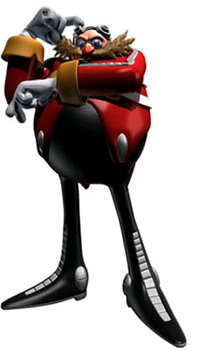BattleFranky202@legacy41984118 (talk | contribs) |
A morris-gpuser (talk | contribs) No edit summary |
||
| Line 51: | Line 51: | ||
[[Category:Main antagonists]] |
[[Category:Main antagonists]] |
||
[[Category:Bosses]] |
[[Category:Bosses]] |
||
| − | [[Category:Video Game Bosses]] |
||
[[Category:Male characters]] |
[[Category:Male characters]] |
||
Revision as of 23:23, 26 October 2008
| Doctor Ivo Robotnik | |
|---|---|
| Information | |
| Game series | Sonic series |
| First appearance | |
| Alias: | Dr. Eggman |
| Japanese name: | Dokutā Egguman |
| Occupation: | scientist |
| Species: | Human |
| Age: | Unknown, speculated to be in 50s |
| Height: | 185 cm (6 ft 1 in) |
| Weight: | 128 kg (282 lb) |
| Gender: | Male |
| Blood type: | B |
| Likes: | Mechas |
| Dislikes: | Losing, failure |
| Hobbies: | Robotics |
| Family: | Gerald Robotnik (deceased), Maria Robotnik (deceased) |
| Power: | I.Q. of 300 |
| Creator(s): | Naoto Ōshima |
Doctor Ivo Robotnik (ロボトニック, Dokutā Robotonikku), also known by his alias, Doctor Eggman, is a video game character and main antagonist of the Sonic the Hedgehog series. He is a comically obese scientist with an IQ of 300. His character designer is Naoto Ōshima, and he has gone through several appearance changes throughout the series.
Concept and inspiration
In April of 1990, Sega requested a game capable of selling over one million copies and a character to replace Alex Kidd as the company's mascot, as well as to rival Nintendo's flagship character, Mario. Several character designs were submitted by its AM8 research & development department, including an armadillo (who was later developed into Mighty the Armadillo), a dog, a spiky hedgehog (which would later become Sonic the Hedgehog), and a rabbit (intended to use its extending ears to collect objects; these aspects were later incorporated into Ristar). A caricature of Theodore Roosevelt was also one of the possible designs, but it lost to Sonic the Hedgehog, and eventually became the basis for Eggman.
Ivo, the character's first name, is reverse of Ovi, a prefix based on the Latin word for "eggs". Robotnik, the character's surname, is the generic Polish word for a worker. As such, it was used as a title by a number of leftist magazines throughout 19th and 20th centuries.

